Table of Contents
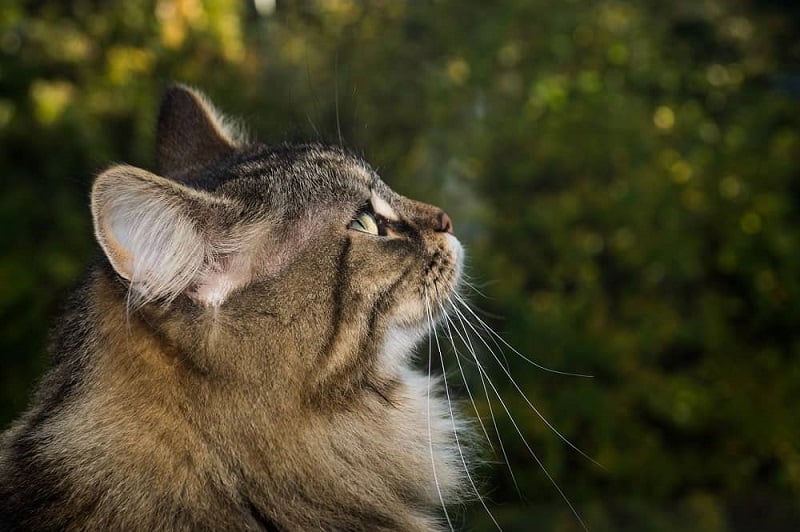
If you want a fluffy, cuddly house pet, the Norwegian Forest Cat, or “Wegie” as it is lovingly known as, is just what you need. This is the official cat of Norway, where it is known as the “skogkatt,” meaning “forest cat.”
The Norwegian Forest Cat looks a lot like the Maine Coon Cat, which make sense seeing as how they are distantly related, but this is a special breed that has very special characteristics.
This is a cat is often referred to as the gentle giant cat which simply means large and gentle, and loves to nurture. It makes a wonderful family pet, and gets along with everyone, including other animals.
Origin
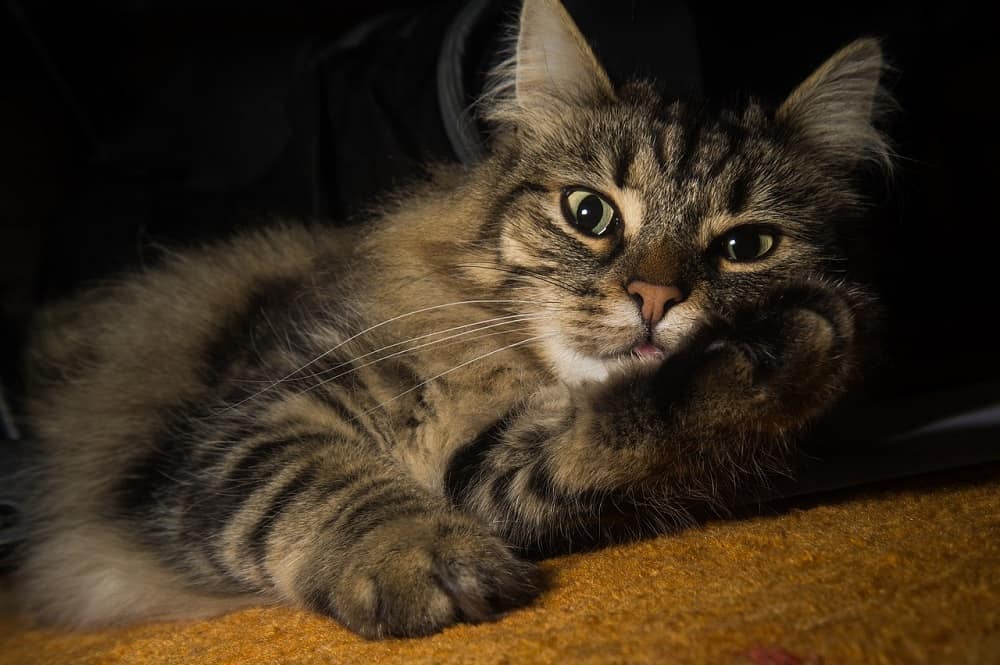
The Norwegian Forest Cat has been a common sight in Norway for as many as 4,000 years or longer. It has a thick coat that is resistant to water, and it is built for the cold, harsh environment of the Scandinavian woods. This is also a cat of myth. Folklore says that these cats pulled the chariot of the Goddess Freya across the sky, and they also hold special places in many Norse fairy tales. Farmers have kept Norwegian Forest Cats for centuries, using them as mousers as well as companions.
Interestingly enough, the Wegie wasn’t recognized as an official breed until 1938, when it was shown at a cat show in Oslo. The development of the breed began at this time, but was put on hold during World War II. Finally, in the 1970’s, Norwegian cat breeders began to preserve the bloodlines of these cats and gave them a standardized appearance. The Norwegian Forest Cat was even declared to be the official cat of Norway by King Olaf V.
The Norwegian Forest Cat came to the United States in 1979, and the breed was recognized by the International Cat Association in 1984, and then the Cat Fanciers Association in 1993. Other cat registries recognize this beautiful and loving breed.
Physical Standards
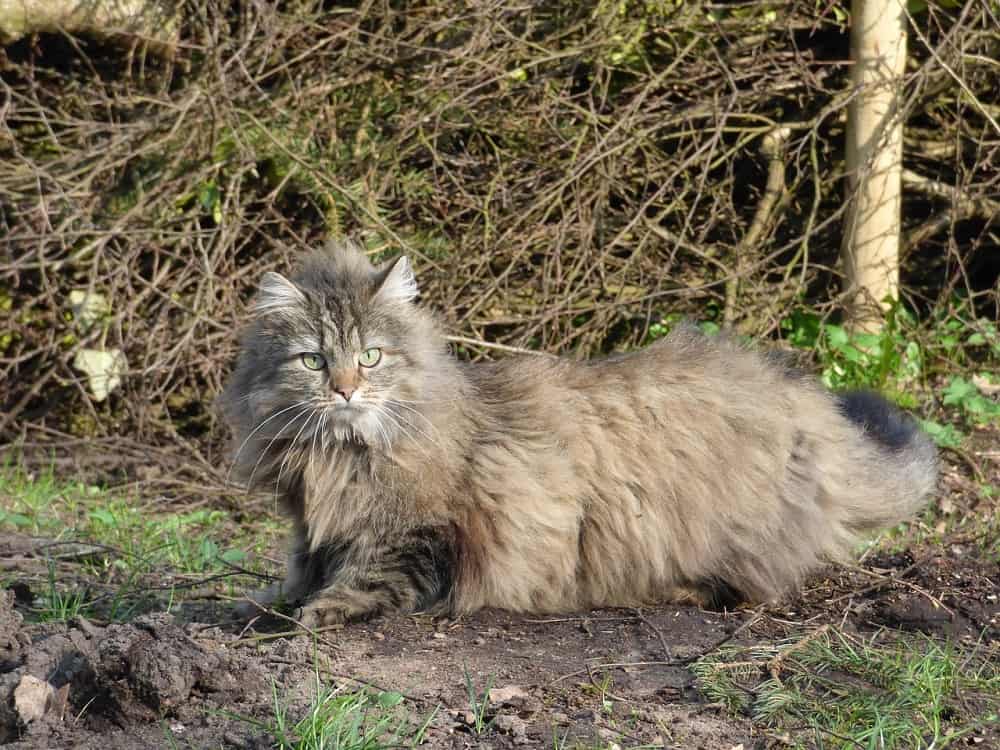
How big do Norwegian Forest Cats get? Usually around 12 pounds (both male and female). When doing a Norwegian Forest Cat size comparison with other house cats, remember that they tend to look larger because they have so much long fur.
It can take up to five years for a Norwegian Forest Cat to fully grow. It is taller than other cat breeds, standing about 12 to 18 inches in height, which can cause some health issues, including hip dysplasia, because of problems during growth.
Other than that, there are not a lot of known health issues associated with this type of cat, and it has a lifespan of around eight to 12 years.
This cat is smaller than its distant cousin, the Maine Coon Cat, but is similar in appearance. The coat is long, straight, and soft, and can be found in a variety of colors, including white, black, red, silver, cream, blue, red, cameo, tortoiseshell, brown, and bluecream.
What is interesting about this cat is that there is no standard color or pattern. You will find Norwegian Forest Cats in just about every cat color, and they have different types of patterns and markings.
For instance, you may see one that is solid color, or they can be bicolor, tortoiseshell, calico, tabby, ticking, smoke, and shaded. The only colors and patterns you will not see are chocolate, lavender, lilac, and Siamese-pointed patterns.
As for the body of this cat, the head is shaped kind of like an inverted triangle, with a point at the chin and getting wider at the top. The ears are medium to large size, and they are tufted.
A Norwegian Forest Cat has almond-shaped eyes that are usually green, gold, or copper in color. But, if you have a white Norwegian Forest Cat, it could have blue eyes, or at least one blue eye.
These cats have powerfully muscled bodies, with large paws that have tufts of fur between the toes. The tails are bushy, and generally as long as their bodies.
Are They Hypoallergenic?
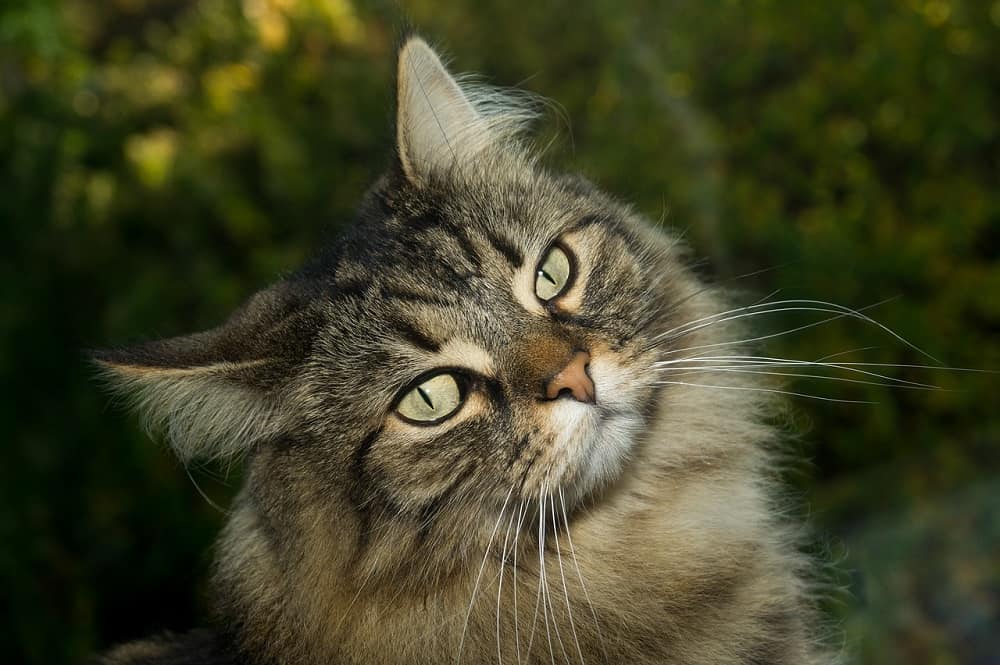
One thing to keep in mind is that the Norwegian Forest Cat is not hypoallergenic. When you come right down to it, there is no such thing as a pet that is, although there are some that cause fewer allergic reactions than others.
The Norwegian Forest Cat actually has a tendency to shed more than other cats because of its long hair, which can be a problem for many allergy sufferers.
Grooming a Norwegian Forest Cat
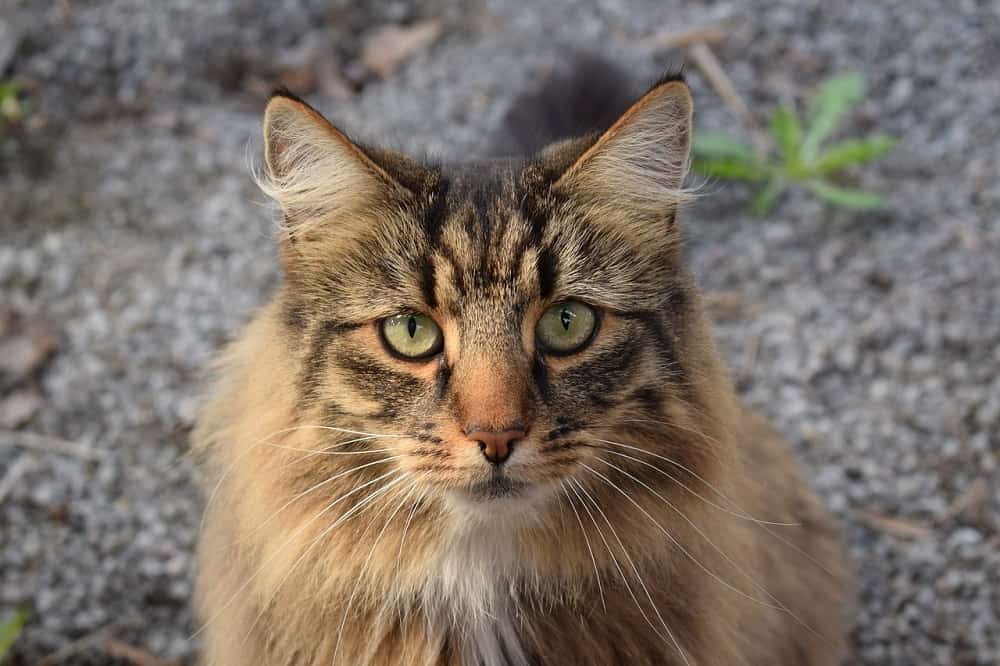
It is true that cats tend to do the majority of their own grooming, but some do need a little bit of human intervention. This is especially true of long-haired breeds, including the Norwegian Forest Cat.
It is important that you brush these cats daily, and it is even better if you are able to brush them more than once each day.
Unless you are going to be showing your cat, it is probably not necessary to bath it, unless it happens to get into something and needs help getting clean. Many owners take their cats to pet groomers who specialize in long-haired cats.
Other than grooming, there is really not much difficulty in caring for a Norwegian Forest Cat, although they do require a lot of social attention.
Activeness
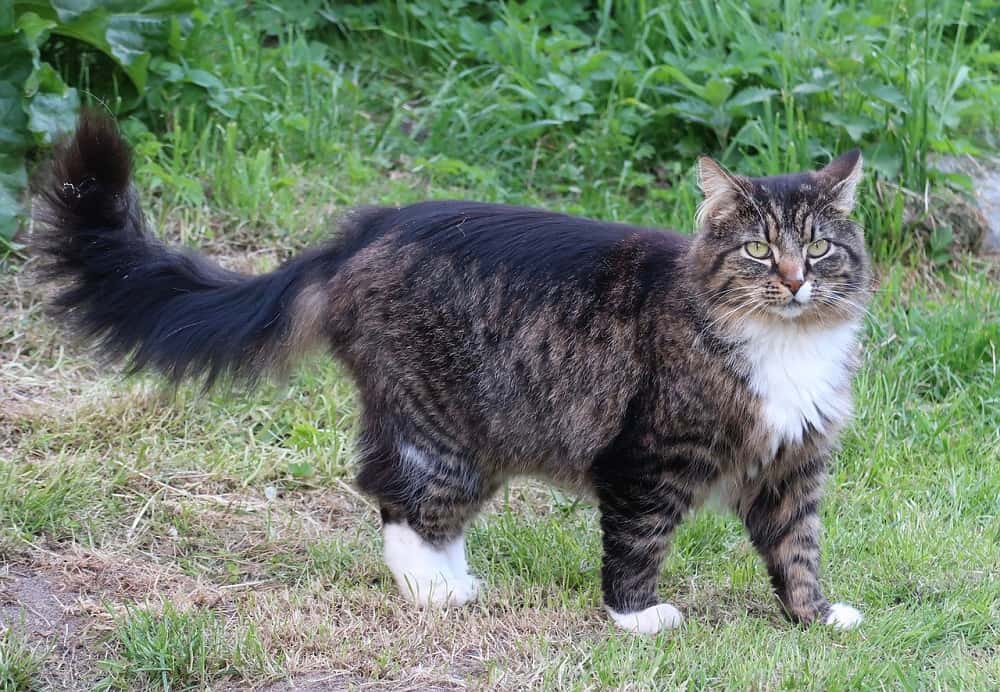
One thing that you should keep in mind is that Norwegian Forest Cats are extremely active.
Remember, they have been used as mousers for thousands of years. So, it is important that you make sure that your cat has plenty of play time, and lots of toys to play with when you are not around.
If your cat is strictly indoors (which it should be), you may want to consider getting a cat wheel so your cat can walk and run for exercise.
Where to Get a Norwegian Forest Cat
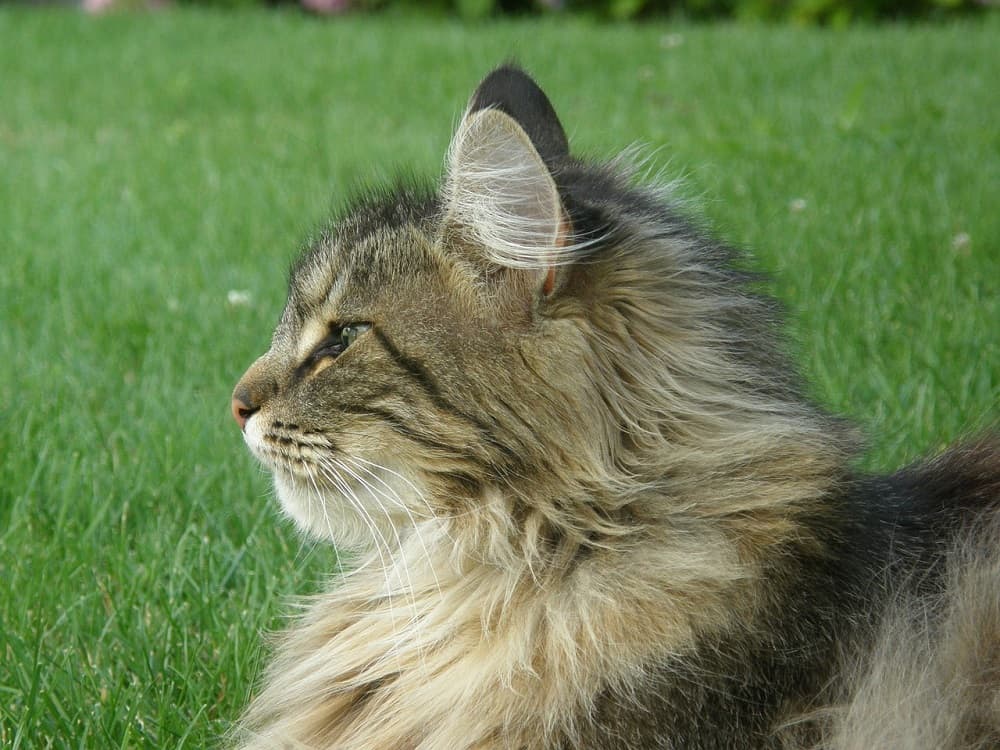
There are different ways that you can get a Norwegian Forest Cat. If you are looking for a cat that you can show or breed, you will want to buy your cat from a reputable breeder. On the other hand, if you are looking for a house pet, there are other options.
The first option should still be a breeder, but there are also times when you might find one at a local shelter, or someone may even have to sell or give away their pet because of allergies, moving, etc. Just remember, if you see an ad for a Norwegian Forest Cat for sale, make sure that you ask plenty of questions before spending any money.
Buying from a breeder is the best option, because you can learn about the cat, and make sure that there are going to be no health issues. Today’s Norwegian Forest Cat breeders tend to let the kittens go at around 12 to 16 weeks of age.
At this point, they have had their first shots, and they have the physical strength and stability to be able to adapt to a new environment. They also have been socialized, so they are not terrified of new people.
How Much Does a Norwegian Forest Cat Cost?
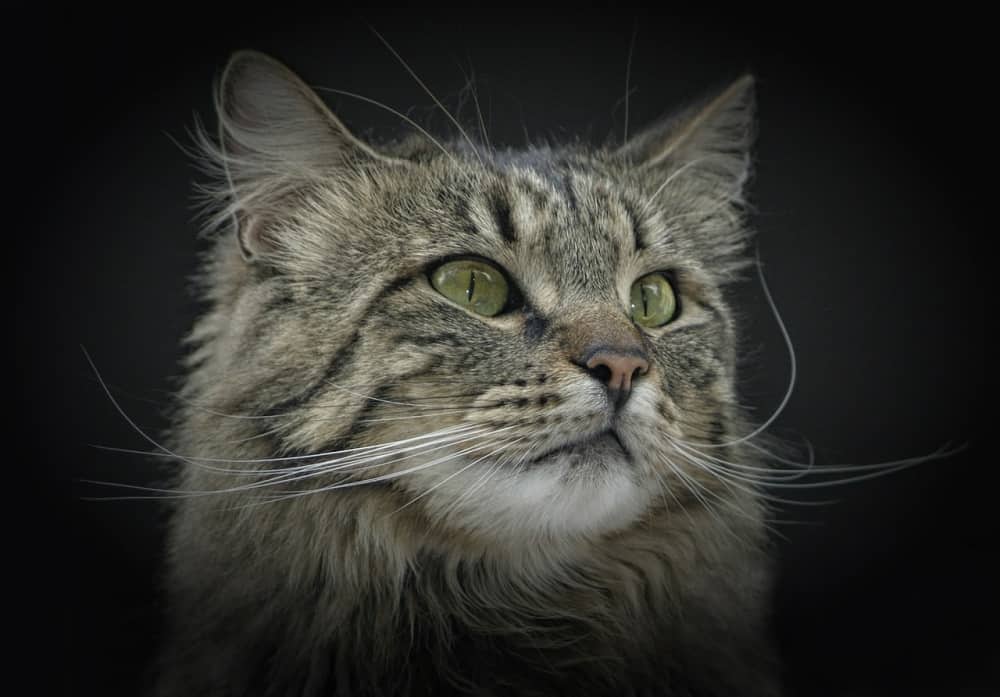
The Norwegian Forest Cat price will depend on a number of factors, and you can expect to pay anywhere from $300 to $800. Of course, there are instances where the Norwegian Forest Cat price could be less or more.
For instance, a rescue at a shelter may cost as little as $100, while one from a breeder with a quality bloodline could cost $1,000 or more.
When discussing how much is a Norwegian Forest Cat with a breeder, don’t forget that most breeders do have to make several trips to Europe in order to research and get cats for their own breeding programs.
You also have to take into consideration titles received through parentage or in competitions, as well as their type and their markings. Also, make sure that you discuss things like spaying and neutering, feeding, veterinary care, and registering the kitten.
Norwegian Forest Cat Owner Responsibilities
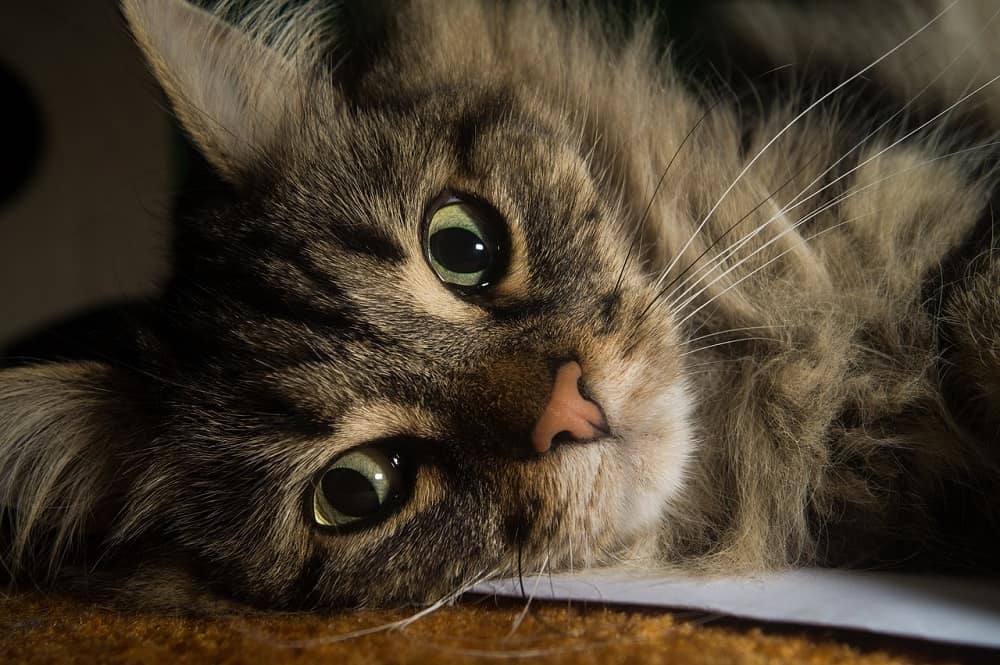
As a pet owner, you are responsible for your cat for at least eight to 10 years, if not longer. During this time, there are many things that you need to do in order to ensure that your pet has a comfortable, healthy, and happy life.
Do not take the responsibilities of pet ownership lightly, especially if you are going to consider getting a cat that could cost hundreds of dollars. Let’s take a look at some of the things that you will need to provide for your Norwegian Forest Cat.
Food and water
You are responsible for providing your pet with the basic necessities of life, including food and water. Make sure that your cat always has access to fresh water, and that their food and water dishes are always clean. Their food should be nutritious, and you may want to discuss the diet with your vet or breeder.
Litterbox and litter
Ideally, your kitten will already be litterbox trained. Make sure that they have a good-size litter box, and that there is always plenty of litter on hand. It is a good idea to have a mat beneath the litter box to catch any litter that might happen to spray out or be on your cat’s feet as they exit the box.
Bed and blankets
It is likely that your cat is going to end up sleeping in your bed with you. But, they also need their own special place where they can nap undisturbed. Make sure that you provide them with a bed and soft blankets to snuggle up in. This can be as simple as a cardboard box, or as elaborate as a brass cat bed.
Toys
As mentioned, Norwegian Forest Cats are highly energetic, so they need to have plenty of toys to play with. Make sure that you have toys for them in every room in your home. That way, if they want to play, they will tend to use their favorite toys rather than destroy something that isn’t a toy.
Now that you know the things that you need to get for your cat, it’s time to talk about the things you need to do in order to care for her throughout her life.
Spay/neuter
We can’t stress enough how important it is to spay/neuter your pet before it reaches sexual maturity.
In fact, unless you are buying your cat so you can breed them yourself, most breeders will insist that the cat be spayed or neutered, and you will need to sign a contract agreeing to this.
An unneutered male cat will mark its territory by spraying, which leaves a foul odor that is nearly impossible to get rid of. An unsprayed female can end up with a variety of health issues, including endometriosis.
Socialization
The breeder will likely have already begun to socialize their Norwegian Forest Cat kittens, and it is your responsibility to continue the process.
These cats are very loving, and they get along with everyone. So, make sure that they are introduced to a number of different people at an early age, and then they will want to make friends with everyone they meet, even neighborhood dogs.
Yes, you can easily have these cats with dogs and there shouldn’t be any issues to worry about.
Exercise
Your Norwegian Forest Cat will need plenty of exercise, for a couple of reasons. For one thing, an overweight cat is not a healthy cat, so you need to make sure that they get enough exercise to help them stay slim and healthy.
Also, these cats have tons of energy. By making sure that they get lots of exercise, you are making sure that they aren’t going to end up using their energy for things that you would rather they weren’t doing, such as destroying things around the house. Agility training is another option.
Keep them indoors
There are some people who think it is cruel to keep a cat indoors all of the time. It is actually a lot more cruel to let them roam around outside, where they can be attacked by other animals, get hit by motor vehicles, pick up parasites and diseases, and face many other dangers.
Some breeders will actually insist that the cats they sell be kept strictly indoors, or only outside when on a leash and accompanied by you, and this will be part of your contract when buying the cat.
Care and attention
A Norwegian Forest Cat doesn’t need much more attention than any other cat you would have in your home, with one exception; they do require more grooming than their short-haired counterparts.
You will need to make sure that your Norwegian Forest cat is groomed regularly, and that it gets plenty of attention. Of course, vet care is also important, and you should be watching your pet for any signs of health issues.
Here’s some additional facts about Norwegian Forest Cats:
Basically, give a Norwegian Forest Cat the same level of care and attention that you would any beloved pet.
Norwegian Forest Cat Characteristics
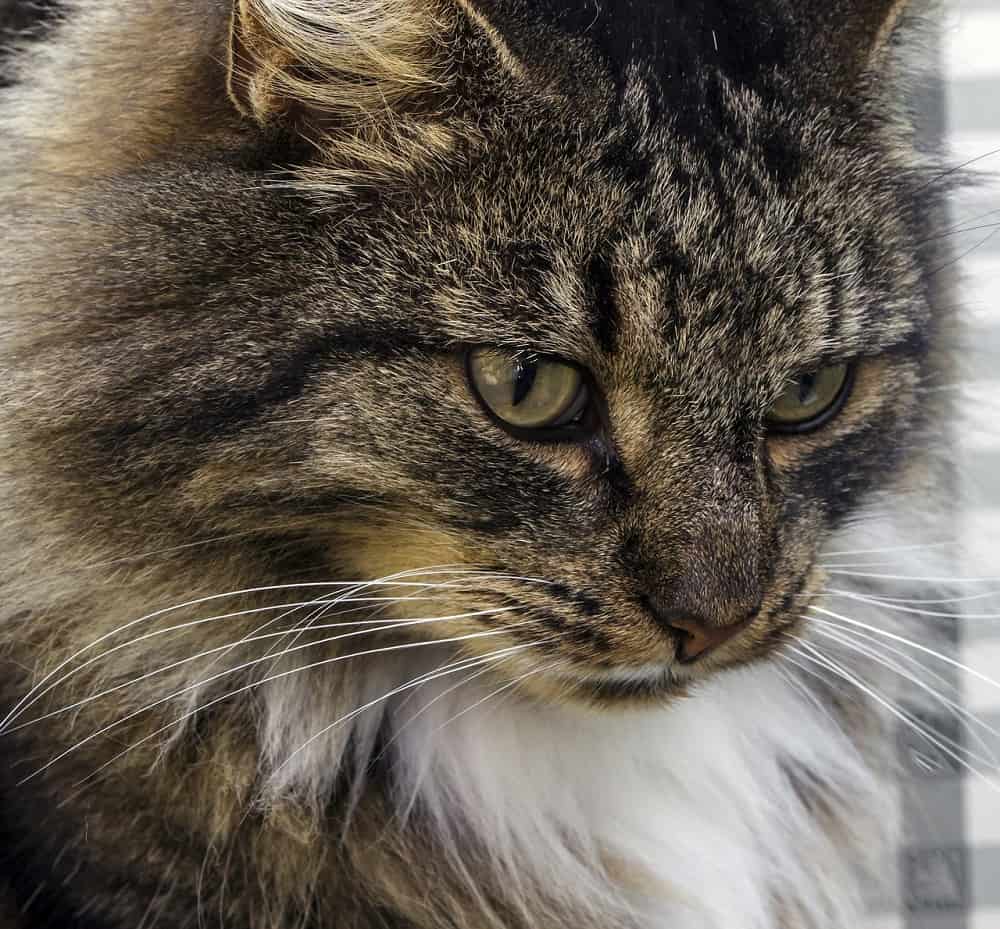
Now it’s time to look at the characteristics of the Norwegian Forest Cat. We have already mentioned that this is a rather large cat, weighing in at around 12 pounds for both male and female cats. It can stand around 16 inches in height, and some can grow even taller.
Of course, the long fur makes these cats look even larger. They are not as large as their distant cousin the Maine Coon Cat, but the fur often makes it look as if they are.
One of the first things we want to talk about in this section is how these cats behave. It has already been noted in this article that these are highly energetic cats, and that they can be a bit destructive if they do not have outlets for their energy.
When it comes to temperament and personality, this is a cat that is mellow and loveable, or in other words, a big baby. This is a cat that is going to follow you around the house wherever you go, so don’t expect to ever use the washroom in peace again.
If you have children or other pets in the home, a Norwegian Forest Cat is an excellent choice. These cats get along with just about everyone, and they are great with children.
Often, you will find children becoming best friends with their Norwegian Forest Cats. Just remember, not only do you have to teach cats how to get along with children, you also need to teach your children how to properly interact with cats and other pets.
These cats are also good with other animals, and there should be no problem having other pets, including dogs in the house, because the Norwegian Forest Cat personality is just that easy going.
Cats by nature are highly intelligent creatures, and the Norwegian Forest Cat is no exception.
While this is a cat that truly loves attention, it is also very independent, and very intelligent. So, be prepared to have a cat that may just be smarter than most of the people in your household.
They are going to figure out how to read each and every one of you, and wrap them around their massive paws. They are also going to make many attempts to communicate with you vocally, using various sounds, including meowing and chirping noises.
Over time, you will likely come to figure out what each of their sounds means, so you can accommodate their needs as they feel they so rightly deserves.
Now we get to the main characteristics of the Norwegian Forest Cat – the colors and patterns. One of the most wonderful things about these cats is that you are not limited to one or two colors or color combinations.
Just about any color and combination you see on most other cats, you will see on Norwegian Forest Cats.
Let’s talk about the coat before we get into the colors. These cats have what is known as a double coat.
When you press the coat with your fingers, you should see an impression left behind. The outer part of the coat is smooth and long, soft, but not dry, and has water-repellent guard hairs that cover the dense and heavy undercoat.
There are three sections of ruff: short back, side mutton chops, and full-frontal bib. The britches are full on the hind legs, but the coat is uneven here, with the undercoat being much less dense. Here is an interesting tidbit.
It takes approximately two years for the coat to completely come in for all colors of Norwegian Forest Cats except for those with the tabby markings and coloration. If you live in a warm climate, you may notice that your cat’s coat is not as long as others of the same breed.
This is because they need to be able to stay cool, especially during the summer months.
Let’s take a look at the coloration of the Norwegian Forest Cat. We can’t just say that these cats are a certain color or pattern. You can find these cats in many different color combinations and patterns, from solid colors to tabbies to calicos and more.
Some will have white spots on their chests and chins (particularly those with tabby markings), and all colors can have white buttons, lockets, and spots.
You will find tabby, orange, calico, black, and many other color combinations and patterns, and some litters can have this type of variety among the kittens.
Norwegian Forest Cat Maintenance and Health Care
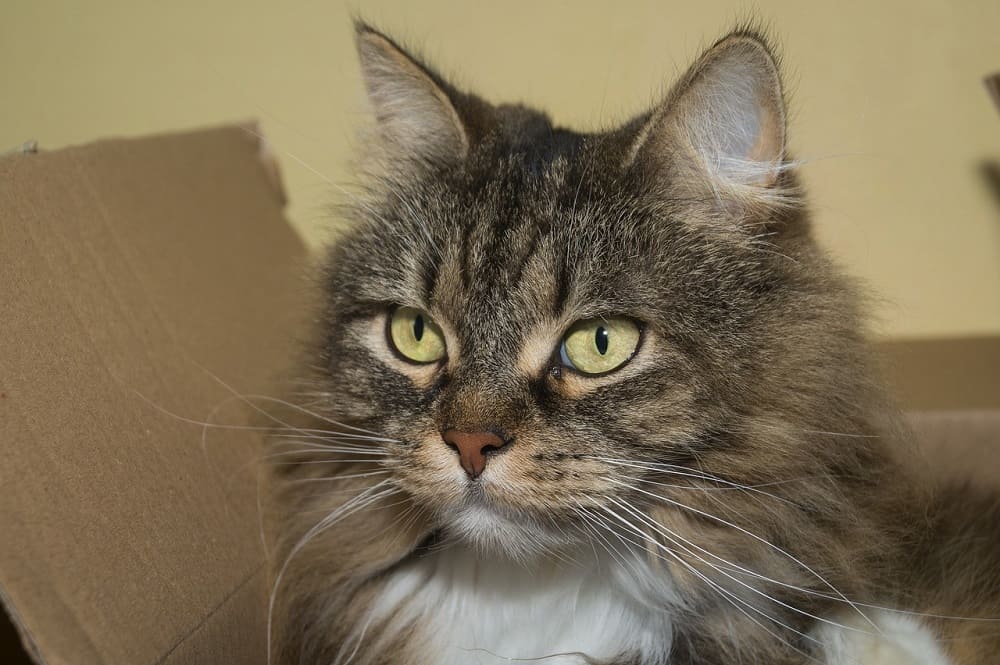
If you are going to invest in a Norwegian Forest Cat, you need to understand about health care, and proper maintenance for one of these cats.
There are some health issues in both pedigreed and mixed breeds that quite possibly might be genetic in nature. But, these are basically very healthy cats that can live 14 to 16 years, and sometimes even longer.
Since it is important to understand the diseases that are seen in the breed, let’s take a look at the most common health issues of the Norwegian Forest Cat.
Glycogen storage disease IV
This is a rare condition that affects how glucose is metabolized. Kittens with this disease are generally stillborn, or do not survive more than a few hours past birth.
Unfortunately, there are some instances where a kitten shows no signs of this disease until they are a few months, and they don’t usually live for more than a few months.
In order to know if a cat is affected and/or is a carrier of this disease, DNA testing is necessary.
Hypertrophic cardiomyopathy
This is a type of heart disease that is inherited in many cat breeds, including the Maine Coon Cat. It is not been proven that it is heritable in the Norwegian Forest Cat, but it is something to watch out for.
Polycystic kidney disease
This is a genetic condition that is progressive, and destroys the kidneys. Unfortunately, there is no DNA test available for this disease to use on Norwegian Forest Cats. But, it can be detected via ultrasound by the time a kitten reaches 10 months of age.
Retinal dysplasia
This is a defect in the eyes that can cause spots on the retina. Fortunately, this is not a serious condition, and it doesn’t have any effect on the cat’s vision.
Now let’s talk about how to care for your Norwegian Forest Cat. As we have already mentioned earlier in this article, it is imperative that you brush your cat’s coat regularly. Some people recommend once or twice a week, but if you can do it daily, or even once or twice daily, it is best.
Not only is it going to help keep your cat’s fur from becoming matted, it will also help to cut down on shedding, which is extremely important if there is anyone in the home who may have a cat allergy.
It is rarely necessary to bath a Norwegian Forest Cat, especially since their coats are pretty much waterproof to begin with, making bathing quite difficult.
Start brushing your cat’s teeth when it is a kitten. This is going to help to prevent periodontal disease. Again, weekly brushing is recommended, but daily cleanings are ideal.
Also, make sure that you wipe your cat’s eyes daily to remove any discharge from the corners, using a soft, damp cloth. Do not use the same section of the cloth for both eyes, so there is no chance of spreading infection if one eye happens to be infected.
Check your cat’s ears each week, and if there is any dirt, wipe it clean with a cotton ball or a soft, damp cloth (dampened with a half and half mix of warm water and cider vinegar). Never use cotton swabs, as they can damage the inner ear.
If you have children, the Norwegian Forest Cat may just be the perfect pet. These are very docile, loving, and gentle cats, and many do not have a problem with being dressed up in doll clothes and wheeled around in doll carriage.
Check the video below for some tips of taking care of your Norwegian Forest Cat:
They love attention, and will follow your children around everywhere in the hopes of being invited to play with them. This is also a great cat to have with dogs, and it is not uncommon to see Norwegian Forest Cats and dogs become the absolute best of friends.
Types of Norwegian Forest Cats
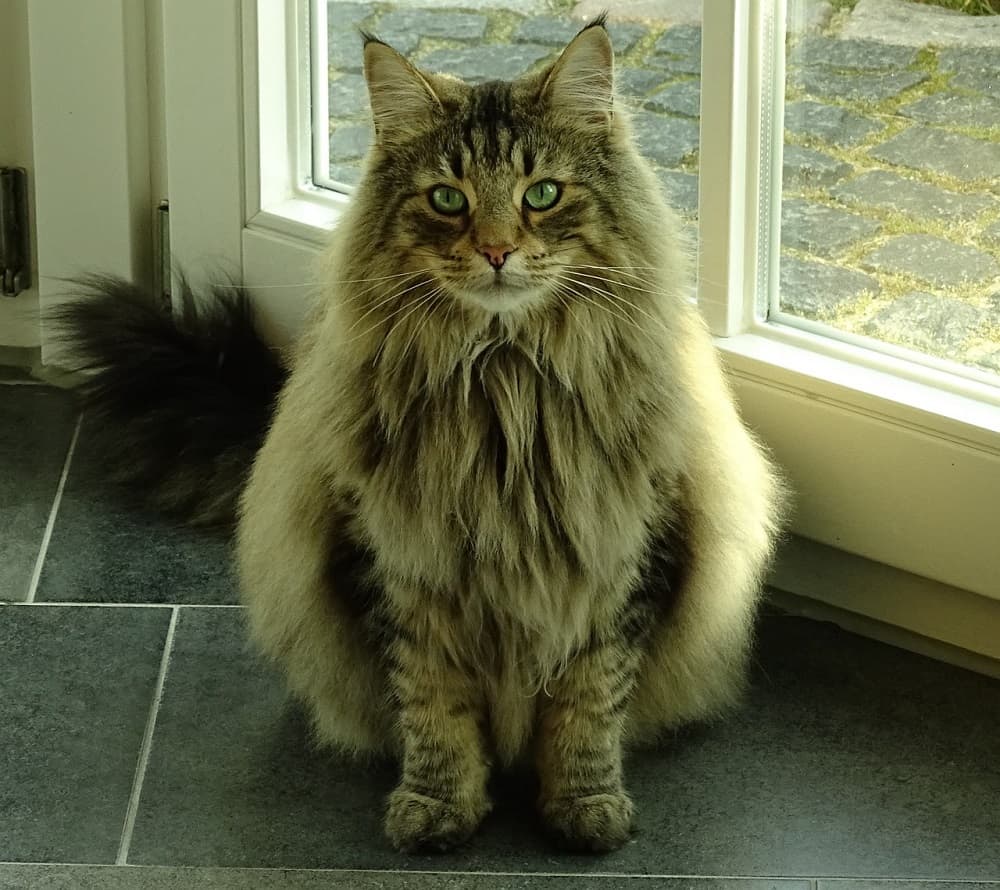
While with many cat breeds there are a variety of types within the breed, there are no specific types of Norwegian Forest Cats. But, there are things to look for that will tell you that a cat is a Norwegian Forest Cat.
Remember, these cats can come in a variety of colors and patterns, so you need to know specific signs to look for. One is the fact that they have those thick double coats.
Their coats are insulated and waterproof, and designed to withstand colder Scandinavian temperatures. Their fur is long and coarse, with guard hairs over the dense undercoat.
They also tend to have a full frontal ruff, a bushy tail and rear britches, and tufted paws, all of which help to provide protection from the snow and cold.
There are only a few colors you won’t see in Norwegian Forest Cats, including chocolate and lilac, and the only pattern you won’t see is one that is like that of many Siamese cats.
A black Norwegian Forest Cat is truly a sight to behold, as is a Norwegian Forest Cat white. There are also orange Norwegian Forest Cats, as well as black and white Norwegian Forest Cats, and most other color combinations in between.
Comparing Norwegian Forest Cats to other Cats
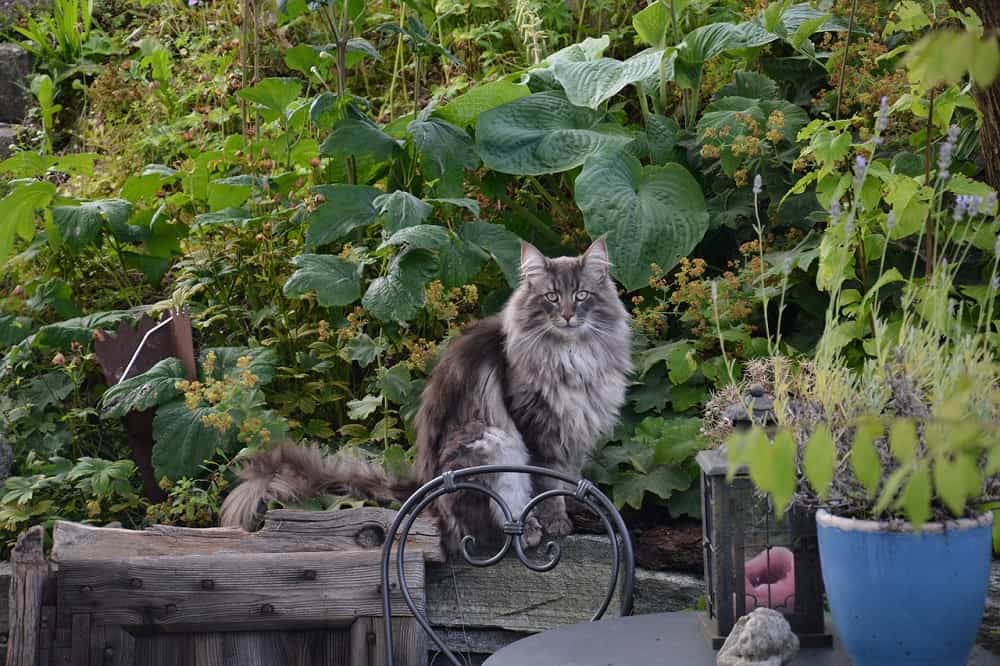
Now it is time to take a look at Norwegian Forest Cats and compare them with their distant cousins, Maine Coon Cats, as well as with average house cats. Let’s start with the Maine Coon comparison.
When it comes to Norwegian Forest Cats vs Maine Coon Cats, both are ideal to have as pets, but there are differences. What is the biggest difference between Maine Coon and Norwegian Forest Cats?
First, we need to look at Norwegian Forest Cat vs Maine Coon size. The Maine Coon can grow to be about twice as large as the Norwegian Forest Cat. They are similar in appearance, and can come in many color combinations. The fur is different, with the Main Coon having much softer and silkier fur that is not waterproof.
Now let’s look at Norwegian Forest Cat vs Maine Coon vs. Siberian. They are all long-haired cats, and all grow to be quite large. Also, all are bred for colder temperatures. But, they all come from different parts of the world, and have very distinct differences in characteristics. All are friendly and loveable, and make great house pets.
As for the difference between Norwegian Forest Cats and regular cats, the biggest difference is the price. Wegies are also a lot larger than a typical house cat, and it is going to require a lot more grooming than other long hair cats, because of the double coat.
Conclusion
If you are thinking about investing in a pedigreed kitty, and you want one that is as beautiful as it is affectionate, the Norwegian Forest Cat is definitely an option to consider. These cats are gentle by nature, and ideal to have around children and other pets.